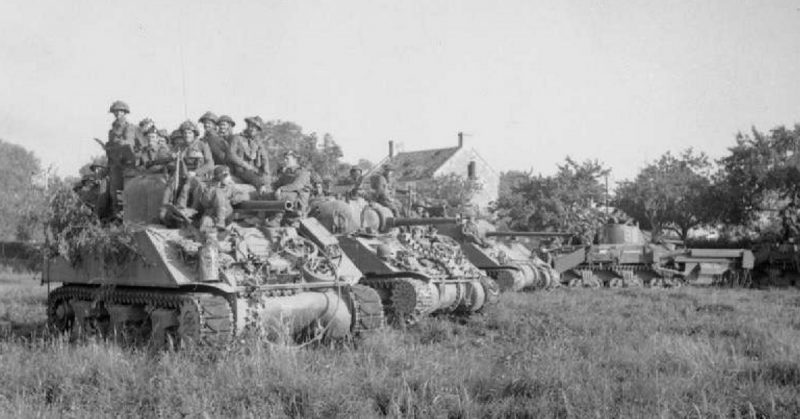At 0525 on July 18th 1944, an artillery barrage erupted on the German positions a few kilometers to the east and southeast of Caen. Ten minutes later there followed the drone of 1,100 British heavy bombers. The British Twenty-first Army Group Chief of Staff, Freddie De Guingand, climbed on top a haystack to witness the spectacle: “It looked just like a swarm of bees homing upon their hives…One appreciated the great bravery of those pilots and crews as they flew into the most ghastly looking flak.”
The British bombers were followed by 977 heavy and medium US Eighth and Ninth Air Force bombers and by sweeps of 300 fighter and fighter-bombers. Some 7,700 tons of bombs were dropped on the German lines, nearly half of them in less than 45 minutes. General Dwight D. Eisenhower, supreme commander of the Allied Expeditionary Force, called it “the heaviest and most concentrated air assault hitherto employed in support of ground operations.” The general allied perception was that the German defenders would be obliterated.
It certainly seemed that way for the panzer crews holed up in an orchard outside of the hamlet of Manneville. A burst from a titanic bomb flung a colossal 58-ton Tiger tank into the air and onto its back. Four Tigers of the 3rd Company 503rd Heavy Panzer battalion, virtually invulnerable to anything but artillery fire and air strikes, were knocked out. Others were smothered in earth that erupted from 30-foot deep bomb craters. Though sheltered in foxholes beneath the steel behemoths, the crews’ nerves snapped. One man went insane while two others committed suicide.
The massive bombardment was the prelude of Field Marshal Bernard L. Montgomery’s “Operation Goodwood.” Commander of overall allied ground forces in Normandy, Montgomery was intend on breaking the deadlock that had set in Normandy since D-Day. Montgomery boasted that “the time has come for a real ‘showdown’ on the eastern flank.”[1] The plan was to have the bombardment paralyze the German defense, leaving it ripe for an armored thrust which would destroy the German armor and reach the open country about the Caen-Falaise road.
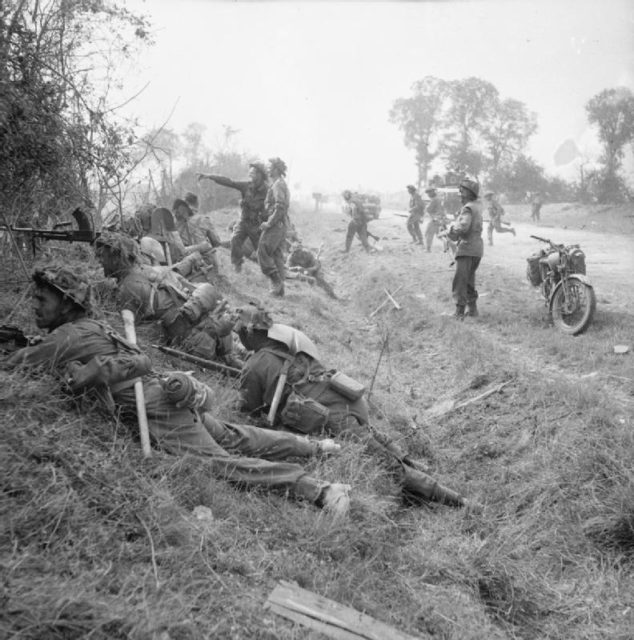
The onus was on Lieutenant General Sir Richard O’Connor’s VIII Armored Corps. Spearheading the attack would be Africa veteran Major General “Pip” Roberts’ renowned 11th Armored Division. After the 11th came Maj. Gen. Allan Adair’s Guards Armored Division with Maj. Gen. Bobby Erskine 7th Armored, the famed “Desert Rats,” bringing up the rear. With some 266 tanks, 361 scout and armored cars and 2,000 trucks in each division, VIII Armored Corps boasted over 8000 vehicles. They would attack southward from the eastern side of Caen, supported by the Canadian II Corps and the British I Corps on its right and left flanks, respectively.
Following a creeping artillery barrage, the Shermans rumbled through the dust over ground pockmarked by bomb craters. The tanks continued in a narrow column, first through the cleared British minefields and then through a two-kilometer wide corridor flanked by the Caen’s factories to the west and a forest to the east. Flat and open ground, sprinkled with wheat fields and hamlets, lay before the main objective of the Bourguébus Ridge.
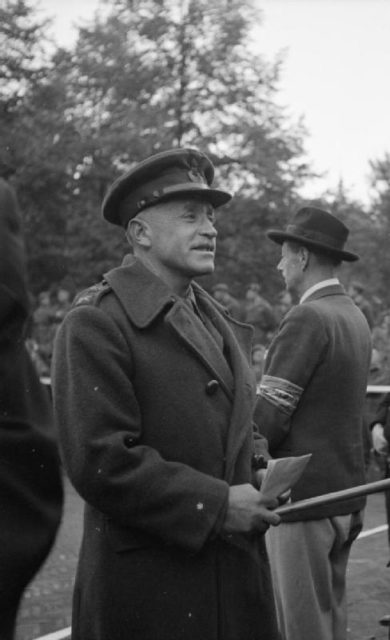
Facing the British-Canadian onslaught was Gen. Hans Eberbach’s Panzer Group West with 194 guns, 272 rocket launchers and 377 panzers and self-propelled assault guns. The already badly mauled and inexperienced 16th Luftwaffe Field Division held the forefront of the German defense. The key division to hold up the British Armor was Lt. Gen. Edgar Feuchtinger’s 21st Panzer Division of Africa Korps fame and its Kampfgruppe (battlegroup) Luck. Major Hans von Luck’s Kampfgruppe included his 125th Panzer Grenadier Regiment and Maj. Alfred Becker’s 200th Sturmgeschütze (assault gun) battalion. On the left flank of Kampfgruppe Luck, panzer grenadiers and a Luftwaffe Panzerjäger (Anti-tank) battalion held the Colombelles factories. The 1st Panzer Battalion and the independent 503rd Heavy Panzer battalion mentioned earlier, covered the right flank. A Nebelwerfer (rocket launcher) battalion provided support from Grentheville.
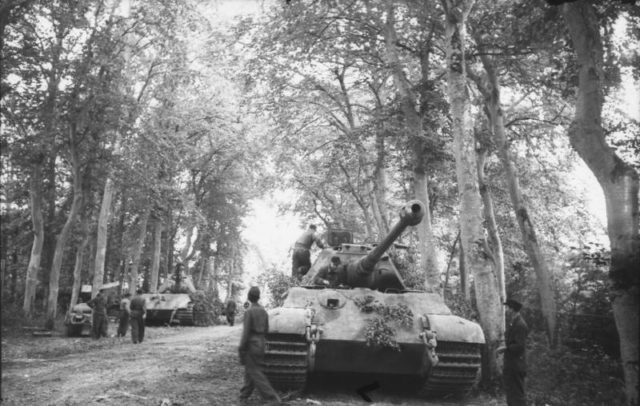
Oberstgruppenführer (SS-Colonel General) “Sepp” Dietrich pressed an ear to the ground and heard the sound resound through the limestone of the Caen plain. Dietrich’s I SS Panzer Corps awaited the Canadians on the German left wing, where General Guy Simmonds’ II Canadian Corps hoped to oust the Germans out of southern Caen. Dietrich’s 272nd Infantry Division had just taken over the forward position in Caen south from the exhausted 12th SS Panzer Division Hitlerjugend. Hitlerjugend joined Dietrich’s other panzer division, the 1st SS Panzer Division Leibstandarte Adolf Hitler in reserve.
Panzer Group West sported the toughest defenses in Normandy, over seven miles deep and far deeper than estimated by the Allies. Most of the vital German positions remained relatively unscathed by the Allied bombardment. This was of little consolidation for those that got hit. The remnants of the green 16th Luftwaffe Field Division were virtually obliterated. Initial German prisoners taken were so stunned that they could not be interrogated for 24 hours. Although most of the Mark IV panzers in the woods between Sanderville and Emviélle were not complete write-offs, they were deluged with tons of soil, fouling their engines. The waves of Shermans shot up four of the Mark IVs and overran another five, capturing their startled crews. The Tigers of the 503rd were either repaired or towed out, sometimes only minutes before the arrival of British tanks.
Colonel David Silvertop’s leading 3rd Royal Tank Regiment reached the Caen-Troarn railway line at 0830 where the 11th Armored Division’s other tank regiments, the 2nd Fife and Forfar Yeomanry, and the 23rd Hussars began to catch up. The British tankers drove by villages of Cuverville and Démouville. Most German survivors remained shell shocked in their trenches. The tanks and motorized companies left them to be mopped up by the British infantry following behind.
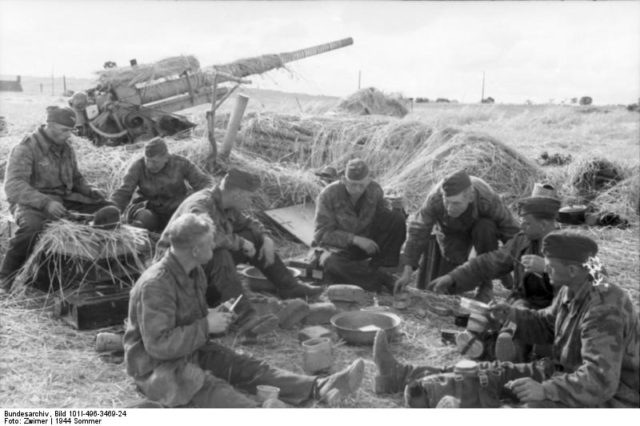
As the ground began to slope upward to the Bourguébus Ridge, the 3rd Royal Tank Regiment veered to the west, while the 2nd Fife and Forfar headed east and then south. Nebelwerfer rockets howled into the air, leaving long blue-white trails, before being overrun by the British tanks. Enemy adversity now picked up dramatically, as the Shermans and their motorized company rolled into the gun optics of Becker’s 75mm self propelled assault guns. Hidden in le Mesnil-Frémentel and in le Poirier, Becker’s guns burst up a handful of Shermans from 3rd Royal Tank Regiment and twelve from the 2nd Fife and Forfar. After inflicting the damage, Becker skillfully withdrew his guns back to the south where more StuGs and 88 dual purpose Flak/Pak stood ready.
Just back from Paris and recently recommended for the Knight’s Cross, Hans von Luck pulled his car into Cagny. Smack-dab in the middle of the British assault, the village had been flattened with 650 tons of bombs in ten minutes. Dismayed, the lean and wiry Luck beheld 25 to 30 British tanks bypassing the western edge of the village. His eyes scanned north, where his 1st Battalion should have been. “My God,” thought von Luck, “the bombing and artillery barrage destroyed the battalion.” When Luck espied a surviving 88mm Flak battery, he at once told its young captain to “hit the enemy in the flank.” “Major, my concern is enemy planes, fighting tanks is your job-I’m Luftwaffe,” replied the captain. Luck pulled out his pistol; “Either you’re a dead man or you can earn yourself a medal.” “I bow to your force,” exclaimed the Captain. What must I do?” Hidden in an apple orchard, the 88s lowered their muzzles at the British tanks. Salvos of 88s zoomed as Luck phrased it, “through a corn field like torpedoes.” Joining the Flak ambush were the last Pak 88 and Mark IV that remained at Cagny, which shot up another sixteen Shermans from the 2nd Fife and Forfar.
On the horizon to the north, flames and clouds of smoke spiraled up from Caen where up to 3000 French civilians perished in the Allied bombing. Silvertop’s 3rd Royal Tank Regiment and its supporting motorized rifle company managed to reach the vicinity of the Cormelles factory area, then turned south toward their objectives of Bras and Hubert Folie. To their right, the 2nd Fife and Forfar pushed toward the eastern leg of the Bourguébus ridge. As the two tank regiments charged up the open slope, scores of 88s, dug-in and camouflaged among the walled brick-and-stone Norman villages, flashed into action.
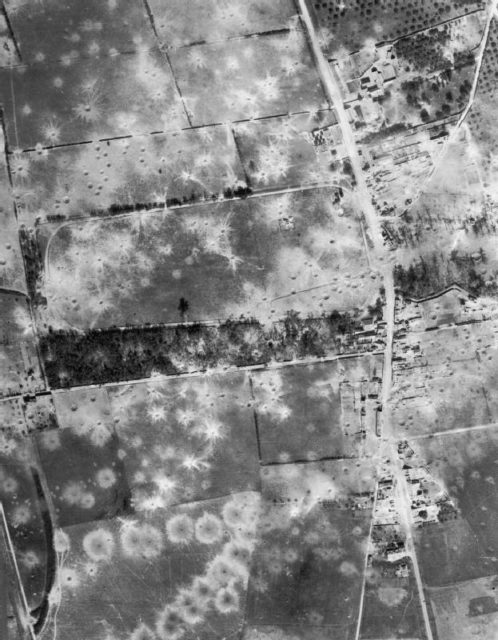
Major Bill Close of the 3rd Royal watched two tanks on his left get knocked out before his own rocked to the impact of an armor piercing round. “Bail out, sir!” shouted his crew. Fortunately all made it out, with Close running over to the next tank, getting inside and resuming command. Despite his bravery, the situation turned hopeless. “Within seconds, 15 of our tanks were stationary and on fire,” he remembered. “We had to break off the advance and withdraw.” The Fife and Forfar fared equally bad. Standartenführer (Lt. Col) Joachim Peiper’s 1st SS Panzer Regiment’s Panthers and StuGs arrived on the ridge, within minutes shooting up another 29 Shermans.
The remaining 11th Armored Division’s tank regiment, the 23rd Hussars, temporarily held back to allow the tanks of the Guards Armored Division to enter the battle. While two Guards regiments bypassed Cagny via a detour through le Mesnil-Frémentel, the third regiment, the 2nd Armored Grenadier Guards, engaged the Cagny 88s and lost more tanks in the process. The 88s were nevertheless under increasing pressure and botched up a relief attempt by nine Mark IVs and ten barely functional Tigers of the 503rd. The 88s mistook their own panzers for Shermans and knocked out two of the Tigers.
Faced with the arrival of the Guards Division’s 32nd Infantry Brigade, the Luftwaffe crews blew up their guns and finally withdrew. Wireless Guards operator G.H. Marsen describes the scene: “I could see Caen just to my right, the whole area was on fire, the earth shuddering from the bombing and shelling. I saw at least 40 Sherman tanks blazing…Our captives were mere boys, running toward our lines with hands on their heads.” Meanwhile the 23rd Hussars had entered the battle, reaching the smoldering tank husks of the 2nd Fife and Forfars near Soliers and Four. The Hussars fared no better and were decimated by Peiper’s SS panzers on the ridge and by Becker’s assault guns in Soliers.
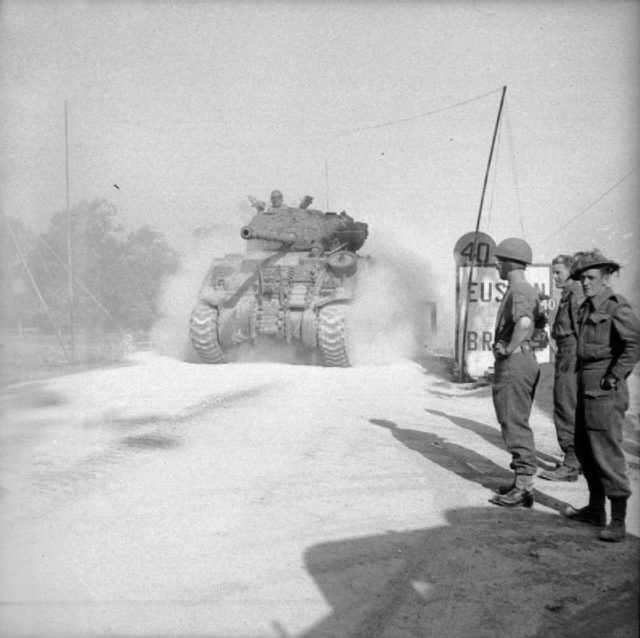
Although the 1st Coldstream Guards captured Le Poirier at 1630hrs, the 2nd Irish Guards were stopped at Vimont. Accompanied by a second Sherman, Lieutenant John Gorman of the Irish Guards drove his tank headlong into a Tiger II plowing through a hedge. The Sherman was faster but its 75 mm shell bounced off the front of the Tiger. When ordered to fire again the gunner replied “Gun jammed sir.” As the Tiger turret slowly turned toward them, the Irish troopers rammed their tank into the Tiger. Both crews bailed out, and with heavy shelling going on, both jumped for cover. Lieutenant Gorman, however, crawled back out and ran to fetch a Sherman Firefly. He returned and “brewed up the Tiger” at point-blank range, then collected his own and the Tiger’s crew.
Heavy fighting continued at the western flank of the battle as Leibstandarte StuGs met Pip Robert’s last reserves, the Cromwells of his 2nd Norhamptonshire Yeomanry Reconnaissance Regiment. Knight’s Cross holder SS-Hauptsturmführer (Captain) Karl Rettlinger remembered his StuG pincer attack, “caught the enemy tanks…two of their tanks burst into flames immediately and some took direct hits. Panic overtook the enemy….We lost not a Panzer. By then it was 1900hrs.”
At the end of July 18th, the 11th Armored Division had lost 141 tanks and the Guards Division another 60. The British advance had crawled to a standstill and Bourguébus ridge remained in German hands. At least VIII Corps had suffered relatively few human casualties losing 521 men, with only 81 killed in the tank regiments. Meanwhile, Canadian II Corps seized the Caen suburbs and factories after a stiff fight while the British I Corps drove the Germans out of Touffreville and Sannerville.
Confusion reigned at the various British headquarters. While the British armor bled to death on the Bourguébus, Montgomery claimed “Complete success…bombing decisive…spectacle terrific…difficult to see what enemy can do…few tanks met so far.” BBC news blurted out the words “Second Army attacked and broke through.” Everyone thought Montgomery had achieved a second Alamein. The feeling was not shared by the soldiers on the front line. They consolidated their positions and funneled in a number of replacement tanks for their mauled regiments. Tomorrow would be surely be another day of hard fighting.
L.H. Dyck’s unabridged Goodwood article, accompanying notes and sources is available at Ludwig H. Dyck’s Historical Writings: Operation Goodwood: Epic Armor Clash in Normandy
- Michael Reynolds, Steel Inferno. 1st SS Panzer Corps in Normandy (New York: Dell Publishing, 1998) p. 207, 208.
